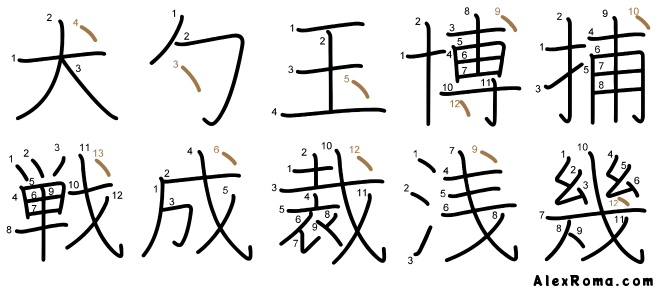Stroke order rule 3 – droplet last
The stroke order rule 3 states:
A small solitary stroke inside a shape, or at the top-right of a shape, is written last.
For memorability I call these kind of strokes “droplets”.
Let’s study the diagram below.

This rule is limited to individual shapes. Some kanji are made up of just one shape, like 犬 inu or 玉 tama above. According to the droplet last rule, the droplet stroke is the last stroke of these two kanji.
Other kanji are made up of two or more shapes. For example, in the diagram above, the kanji 捕 toraeru is the union of two shapes. The droplet is the last stroke of the shape on the right (in this case it also happens to be the last stroke of the entire kanji too).
The kanji 博 HAKU is the union of three shapes, and it contains two droplets. One droplet is the last stroke of the top-right shape, and the second droplet is the last stroke of the bottom-right shape 寸 SUN.
The droplet is the last stroke of the particular shape it belongs to.
I would like to present another kanji before we conclude this rule: the kanji 器 utsuwa.

The kanji 器 utsuwa is the union of four 口 SAI ‘sacred vessel’ shapes, and one 犬 inu ‘dog’ shape. That’s a total of five shapes within one kanji. It is clear that the droplet is the last stroke of the shape 犬 inu, but it is not the last stroke of the entire kanji 器 utsuwa.
(The kanji 器 utsuwa ‘vessel’ represents four sacred vases and a sacrificial dog that were used in ancient religious ceremonies. This kanji underwent a mindless “simplification” and its currently utilised shape is 器 utsuwa. Having lost its droplet, the original meaning of this kanji has become obscured.)
Exceptions: droplets that are not written last
The droplet last rule only applies to droplet-like strokes that are solitary, and either:
- located at the top-right of a shape, or
- inside a shape.
If a droplet is located somewhere else, or if it belongs to a group of droplets (it’s not solitary), then it is not written last.

The kanji in the diagram above contain droplet shapes that are not written last.
- The droplets in 空 sora and 言 iu are solitary, but they are not in the top-right; they are in a top-central position within their shapes. As such, they are not written last.
- The kanji 神 kami and 権 KEN contain the shapes ⺭ shimesuhen and 隹 furutori, which contain droplet strokes. These droplets, although solitary, are also centred, so they are not written last.
- The kanji 図 ZU contains paired droplets. The droplets are not solitary, so they are not written last.
All the droplet strokes in the diagram above follow the normal kanji stroke order rules: top-to-bottom, left-to-right, etc.
